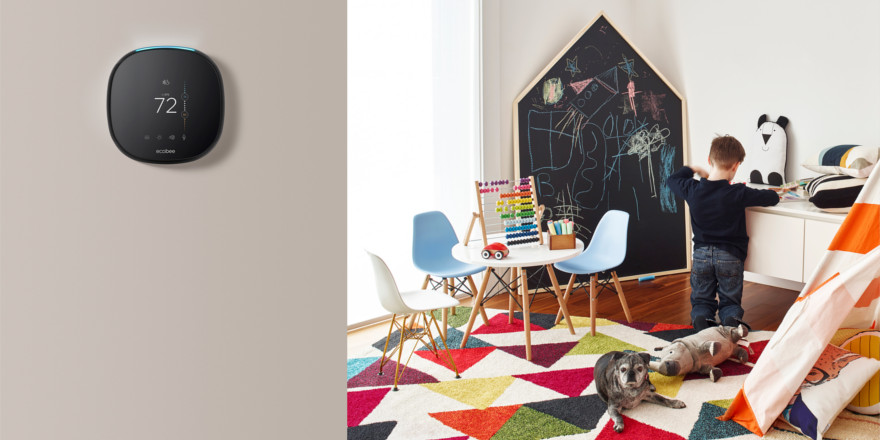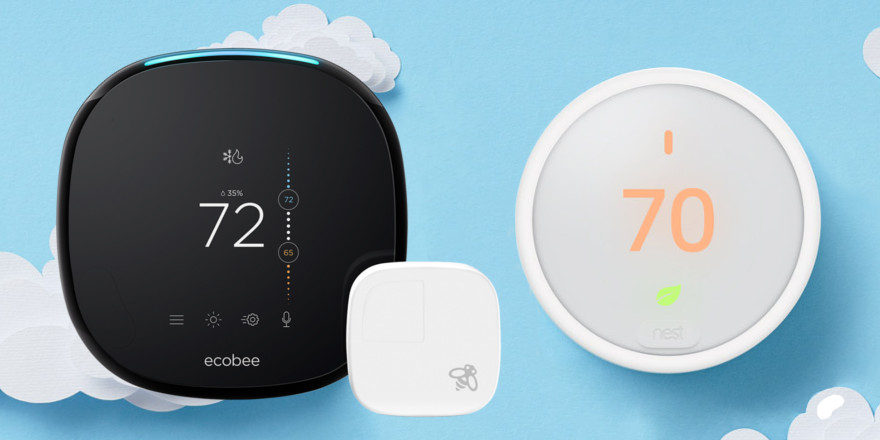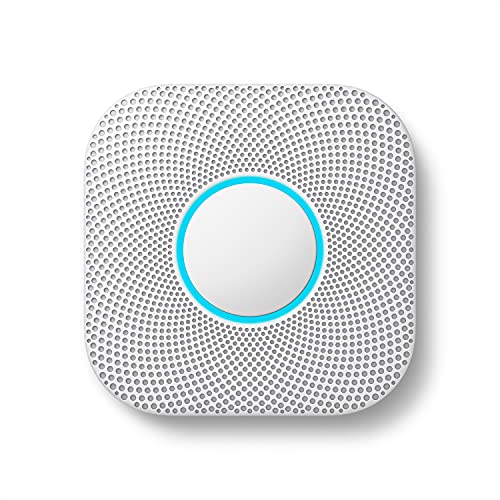When considering a new thermostat to add to your home, there are a lot of different aspects to consider. Do you go with a traditional thermostat? Their upfront cost is a lot lower, and we’ve all used these devices for years. But in 2017, there are many more options available that take advantage of the recent progress in smart technology. While these thermostats may look more expensive up front, they can often save homeowners significant amounts of money on heating and cooling bills over the course of the product’s lifetime.
After just a few months, these smart thermostats will often pay for themselves. Add to that the convenience of smart home integration, and you have a recipe for an automated and more efficient home.
So, let’s take a look at two popular devices: the Nest E vs. the ecobee4. Both of these products have their advantages and disadvantages, and by the end of this article you’ll have a much better sense of which thermostat works best for your home and your lifestyle.
Nest E vs. ecobee4 — Differences
-
Difference #1: Amazon Alexa – One big difference between the Nest E and ecobee4 is the thermostat’s interaction with Amazon Alexa. The company’s foray into a virtual assistant has quickly exploded into a whole suite of smarthome tools, with many manufacturers supporting Alexa and designing their products to work around this central hub.
The Nest E lacks any sort of voice and audio features, while the ecobee4 has built-in Alexa Voice Service that can listen to you and respond to your commands.
Users with a smart home environment that revolves around Alexa, or even just people who desire a voice activated device, will be better suited with the ecobee4. Keep in mind that the Nest E still qualifies as a “smart” device and works with Alexa, but it’s not able to respond to voice commands on its own.
-
Difference #2: Compatibility – Compatibility is a major consideration, as proper integration with your smart home environment is really important. Not long ago you’d have to choose between Apple (ecobee) and Google (Nest) — not anymore. Ecobee now supports both Apple HomeKit and Google Assistant, which makes it an overall better thermostat. So, good news to Google Home fans. Just say: “OK Google, make my home warmer” and enjoy the results.
Besides Apple HomeKit and Google Assistant support, ecobee4 also works with Amazon Alexa.
Unfortunately it doesn’t support ESP (Echo Spatial Perception).ESP is the technology that allows Alexa to determine which echo device is closest and respond in kind.You may run into situations where both your thermostat and your Echo are responding to inquiries, which can definitely get annoying. But ecobee has noticed this problem, and we think that they’ll implement a fix in the near future.[alert-success]Welp, not anymore! Good news: As of July 25th 2018, Amazon has moved ESP to the cloud! So, now every Alexa-enabled device supports ESP. No need to create different names for your Alexa-enabled thermostats or smoke detectors! All Alexa-enabled devices will now work together to deliver one of the best voice control experiences.
[/alert-success]In addition to all the above integrations, the ecobee4 is also compatible with Samsung SmartThings, Wink, and IFTTT.
The Nest E offers less compatibility: it works with Amazon Alexa, Google Home, Wink, and IFTTT. It’s also possible to set it up for Samsung SmartThings integration using a custom setup by a developer in the SmartThings development community.
-
Difference #3: Connectivity – There’s also a difference in connectivity and device integration when comparing the Nest E and ecobee4.
The ecobee4 is generally more fully-featured, with support for additional HVAC accessories like humidifiers, dehumidifiers, ventilators, and HRVs or ERVs. This integration allows you to control not only your home’s heating and cooling, but also the humidity levels of your home. While not necessarily an integral part of a thermostat, it’s definitely a much appreciated convenience that further adds to your smart home’s functionality.
The Nest E does not support additional HVAC accessories, but functions very well as a basic smart thermostat.
You may begin to get the sense that the ecobee4 is a “superior” product, and in general that’s true. One important consideration, however, is that this premium model comes with a premium price tag. In general, the Nest E will get the job done — and do it a whole lot cheaper! But, we’ll get to the cost difference a bit later.
-
Difference #4: Bluetooth Low Energy – One advantage that the Nest E has over the ecobee4 is support for Bluetooth Low Energy Technology. This is a neat perk that allows the thermostat to use less battery power while maintaining high data speeds.
The ecobee4 does not support Bluetooth Low Energy, and in general will consume a little more power that the Nest E.
-
Difference #5: Display – The Nest E unfortunately falls short in the display department. Despite featuring a 24 bit color LCD with a 320 x 320 resolution, the display is hidden behind a frosted glass finish that sort of takes away from readability. The 182 pixels per inch are somewhat useless in the end as the on-screen data is a bit obscured.
It’s somewhat understandable, considering Nest’s goal with the Nest E was to make an easy-to-use thermostat with wide appeal. It looks pretty similar to a regular thermostat, that’s for sure, but we think it’s more of a “con” than a “pro”.
The ecobee4, on the other hand, truly feels like a premium model. It has a sleek full-color LCD touch screen on a 320 x 480 pixel display that’s both beautiful and functional.
They’re two different displays, with two different looks, for two different kinds of consumers. It really depends on what you’d like your thermostat to look like — we prefer the ecobee4 display.
-
Difference #6: Remote Sensors – The two models differ slightly in the way that they expand temperature sensing.
Instead of basic remote sensors, the Nest E utilizes Nest Protect, a smoke alarm that plays double duty as a sensor. There’s a maximum number of Protects that can be used per home, but the 18 sensor limit shouldn’t bother most people. After all, 18 smoke alarms is kind of a lot!
The ecobee4 comes with one sensor, but more ecobee sensors can be purchased separately for a reasonable price. You can connect up to 32 sensors to a single thermostat, trumping the Nest E’s offerings.
To sum it up, it’s generally less expensive to expand temperature sensing coverage with the ecobee4 compared the Nest E.
Update 05/05/18: You can now buy the Nest Temperature Sensors to even out the temperature between rooms in your home. The Nest Temperature Sensors work only with the Nest Learning Thermostat Gen 3 and the Nest E Thermostat.
-
Difference #7: Power – Like most thermostats, both the Nest E and the ecobee4 function most ideally with a C-wire. However, both models also offer additional power options.
The ecobee4 can also function using its Power Extender Kit, but the Nest E uses a slightly more unconventional manner of alternative power. In the absence of a C-wire connection, the Nest E uses a lithium-ion battery for power. This battery is connected to the heating and cooling wires and is charged via periodic “pulses” to the furnace. Sounds pretty cool, right?
The issue with this system comes with the fact that these pulses often cause a furnace to turn on and then quickly shut down. This sort of rapid cycling can reduce energy efficiency, reducing the effectiveness of the thermostat overall.
So, without a C-wire, the Nest E ditches a power cord, but adds an unnecessarily difficult power system in the process. We’d give the alternative power advantage to the ecobee4.
-
Difference #8: Size – There are some differences in size when comparing the Nest E and ecobee4. The Nest E is a little smaller with a greater depth, while the ecobee4 is a larger, slimmer model.
Nest E — Diameter: 3.19 in (8.1 cm); Depth: 1.14 in (2.89 cm)
ecobee4 — Diameter: 4.29 in (10.9 cm); Depth: 1.03 in (2.62 cm) -
Difference #9: Color – If the color of your thermostat is of concern, this difference may make your decision a whole lot easier.
The Nest E is only available in white, while the ecobee4 is only available in black.
-
Difference #10: Warranty – Warranty is an important consideration when purchasing any sort of technology — especially when it’s technology that controls the comfort of your home.
The Nest E features a 1 year warranty, and that pales in comparison to the impressive 3 year warranty that backs the ecobee4. If you’re worried about the longevity of your thermostat, you may be better served opting for the latter.
After all, you’ll want to make sure that your investment actually pays off. Ensuring you have proper access to reasonable repairs and replacements may make the ecobee4 a better choice for peace of mind.
-
Difference #11: Environment Learning – The Nest E is unique in that it’s part of the Nest Learning Thermostat family. In true “smart” device fashion, the thermostat takes note of the temperature you set at different times of the day and puts together an automatic schedule for you. It’s incredibly convenient to have a device that anticipates your needs. This can lead to cool perks like automatic temperature adjustments based on whether or not you’re home during the workweek, for example.
While the ecobee4 is not a learning thermostat, it does have the capability to always maintain a comfortable temperature and save energy based on room occupancy. It lacks the automatic anticipation of the Nest, but can react in the moment to accomplish basically the same goals. Additionally, the ecobee4 provides a convenient monthly report on how much energy you’ve saved with recommendations on how to save more.
-
Difference #12: Price – It may be easy to draw a conclusion from this article that the ecobee4 is generally more fully featured, but we would be remiss to neglect mentioning the large price difference between the two models.
The Nest E retails at a lower price point and provides a great thermostat with basic — and in some cases impressive — smart functionality.
The ecobee4 is a fair bit more expensive than the Nest E. Whether the additional features are worth the additional cost is going to be up to you, but to compare these models without bringing up the price difference would make this an incomplete article.
Nest E vs. ecobee4 — Comparison Chart
| ecobee4 | Nest E | |
|---|---|---|
| Amazon Alexa built-in | Yes | No |
| Dimensions | 4.29” x 4.29” x 1.03″ | 3.19” x 3.19” x 1.14″ |
| Hardware color | Black | White |
| Bluetooth LE | No | Yes |
| Wi-Fi | Yes | Yes |
| Remote sensors | ecobee room sensors | Nest Protect Nest Temperature Sensor |
| Humidity sensor | Yes | Yes |
| Power (if no C-wire present) | Power Extender Kit | Heating/Cooling Wires + Battery |
| Voice & audio | Yes | No |
| Learns habits over time | No | Yes |
| Works with Amazon Alexa | Yes | Yes |
| Google Assistant support | Yes | Yes |
| Works with Wink | Yes | Yes |
| HomeKit-enabled | Yes | No |
| Works with SmartThings | Yes | No |
| iOS App | Yes | Yes |
| Android App | Yes | Yes |
| Web Access | Yes | Yes |
| Free monthly energy reports | Yes | Yes |
| Warranty (years) | 3 | 1 |
Nest E vs. ecobee4 — Our Thoughts

Overall, both devices provide great smart functionality that will save you money despite the higher initial investment.
It’s clear from this comparison that there’s a fair amount of differences between the two models. Whether you opt for the Nest E with its unique “learning” functionality or the ecobee4 with its bevy of premium features, you’ll be choosing a thermostat that will elevate your smart home to the next level.
We hope that the information in this comparison helps out as you try to make the decision that’s right for you. At the end of the day, the choice is going to be personal based on you and your family’s collective needs.
Discover more smart home thermostats with our article: Ecobee3 vs. Ecobee4 vs. Nest — What’s the Difference?.
Last update on 2024-04-23 at 16:01 / Affiliate links / Images from Amazon Product Advertising API







Is the Nest E definitely compatible with Wink? Only the main learning thermostat is available to add in the app. Is this something you personally tested with success?
Hey Soumik,
We did three things: we checked the site and found this and this, then figured it’s a software feature and assumed the newer model would keep up with the older one, and then talked to a Nest rep just to make sure — it’s confirmed that the Nest E works with Wink.
So yes, the Nest E works with Wink. If you’re having an issue, you should probably get in contact with them.
– Joseph